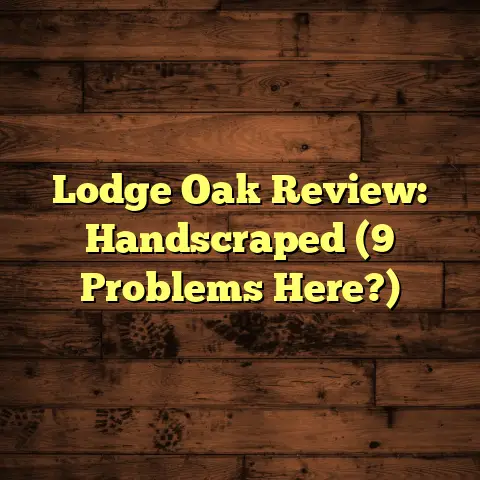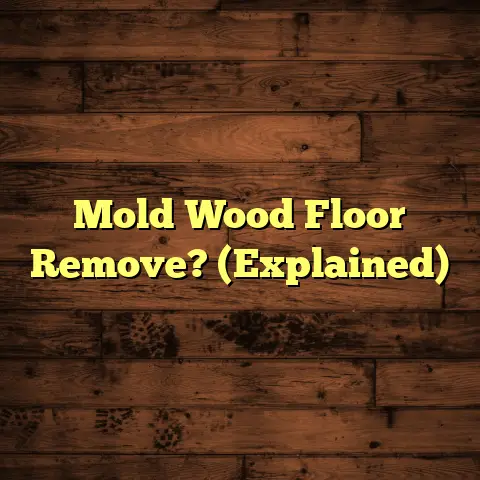Concrete Flooring Cost Philippines (Explained)
Concrete flooring has become increasingly popular in the Philippines, offering durability, versatility, and aesthetic appeal.
However, understanding the costs involved in concrete flooring installation is essential for homeowners and business owners alike.
This article provides a comprehensive overview of the major cost factors, cost breakdowns, comparisons with alternative flooring options, and maintenance tips to help you make informed decisions about your flooring projects.
Overview of Major Cost Factors
When estimating the cost of concrete flooring installation, several key factors come into play:
1. Area Size
The size of the area to be floored significantly impacts the overall cost.
Larger spaces generally benefit from economies of scale, leading to lower per-square-meter costs compared to smaller areas.
2. Concrete Type
There are various types of concrete flooring, including:
- Polished Concrete: Known for its shiny finish and durability, polished concrete is often used in commercial spaces.
- Stained Concrete: Offers a unique aesthetic with color options but may require additional sealing.
- Stamped Concrete: Mimics the appearance of stone or brick; however, it can be more expensive due to the intricate designs.
The choice of concrete type directly affects the material cost.
3. Labor Costs
Labor costs can vary based on location and the complexity of the installation.
Skilled labor will charge more, particularly for specialized techniques like stamping or polishing.
4. Additional Considerations
- Floor Removal: If you have an existing floor that needs to be removed, this will incur additional costs.
- Subfloor Replacement: An unstable or damaged subfloor may need replacement, impacting overall expenses.
- Material Grade: Higher-grade materials typically come at a premium price.
- Room Size/Layout: Complex layouts may require more labor and materials.
- Installation Type: Whether you choose to install it yourself (DIY) or hire professionals will significantly affect your budget.
Detailed Cost Breakdown
Cost Per Square Meter
As of October 2023, the approximate costs for concrete flooring installation in the Philippines are as follows:
- Basic Concrete: ₱800 – ₱1,200 per square meter
- Polished Concrete: ₱1,500 – ₱2,500 per square meter
- Stained Concrete: ₱1,200 – ₱2,000 per square meter
- Stamped Concrete: ₱2,000 – ₱3,500 per square meter
Cost Estimates Based on Project Size
Comparison with Alternative Flooring Options
When considering flooring options, it’s essential to compare concrete with alternatives like laminate, vinyl, and carpet.
1. Laminate Flooring
- Cost: Approximately ₱800 – ₱1,500 per square meter
- Durability: Good but not as long-lasting as concrete
- Maintenance: Easier to maintain than concrete but less resistant to moisture
2. Vinyl Flooring
- Cost: Approximately ₱600 – ₱1,200 per square meter
- Durability: Good water resistance; suitable for high-moisture areas
- Maintenance: Low maintenance; easy to clean
3. Carpet
- Cost: Approximately ₱400 – ₱1,200 per square meter
- Durability: Less durable; prone to stains and damage
- Maintenance: Requires regular cleaning and maintenance
While laminate and vinyl are generally cheaper upfront, concrete offers superior durability and aesthetic versatility over time.
Signs That Hardwood Floors Need Replacement
Although this article focuses on concrete flooring costs, understanding when to replace hardwood floors is also vital for homeowners considering various flooring options:
- Deep Scratches or Gouges: When refinishing cannot restore the floor’s appearance.
- Warping or Buckling: Indicates moisture damage that may compromise structural integrity.
- Severe Discoloration: Stains that cannot be removed through cleaning or refinishing.
- Persistent Odors: Signs of mould or decay beneath the surface.
Pros and Cons of Concrete Flooring
Pros
- Durability: Highly resistant to wear and tear.
- Low Maintenance: Easy to clean and maintain.
- Versatility: Can be customized with stains or patterns.
- Eco-friendly Options: Sustainable materials are available.
Cons
- Cold Surface: Can feel cold underfoot unless heated.
- Hardness: Less forgiving on joints; not ideal for areas where people stand for long periods.
- Potential Cracking: Susceptible to cracking if not installed properly.
Professional Installation vs DIY
Cost Differences
Professional installation can range from 20% to 40% more than a DIY approach.
However, it is crucial to weigh the benefits against potential risks associated with DIY projects.
Tools and Skills Required
DIY installation requires:
- Tools (e.g., trowels, mixers)
- Knowledge of concrete mixing and pouring
- Experience in finishing techniques (polishing/stamping)
Hiring professionals ensures proper installation and reduces the likelihood of future repair costs.
Questions to Ask Concrete Flooring Contractors
When seeking quotes from contractors, consider asking:
- What is included in your estimate?
- How many projects have you completed similar to mine?
- Can you provide references from past clients?
- What warranties do you offer on materials and workmanship?
- How do you handle potential complications during installation?
Hardwood Floor Care and Maintenance Tips
To maximize the longevity of your concrete floor:
- Regular Cleaning: Sweep or vacuum regularly to remove debris.
- Mopping with a Damp Cloth: Avoid soaking the floor; use minimal water.
- Use Area Rugs: Protect high-traffic areas from wear and tear.
- Sealants: Regularly apply sealants to protect against moisture and stains.
Conclusion
Understanding the costs associated with concrete flooring installation in the Philippines can help you make informed decisions for your home or business.
By considering various factors such as area size, concrete type, and labor costs while comparing with alternative flooring options like laminate and vinyl, you can determine the best fit for your needs and budget.
Whether you decide on professional installation or a DIY approach, ensuring proper care and maintenance will keep your floors looking their best for years to come.





